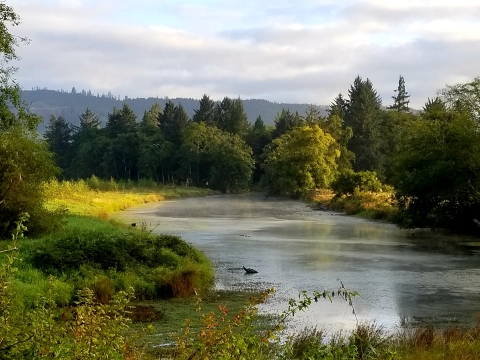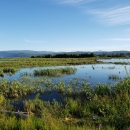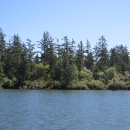About Us
Willapa National Wildlife Refuge was established in 1937 to protect migrating birds and their habitat at a time when many estuaries and shallow water bays were being destroyed in the name of progress. The refuge has grown to encompass diverse ecosystems including salt marsh salt marsh
Salt marshes are found in tidal areas near the coast, where freshwater mixes with saltwater.
Learn more about salt marsh , mud flats, forest, freshwater wetlands, streams, grasslands, coastal dunes and beaches. This rich mix of habitats provide places for over 200 bird species to rest, nest and winter, including over 30 species of waterfowl (ducks and geese) and over 30 species of shorebirds. Other animals such as chum salmon, Roosevelt elk, and over a dozen species of amphibians benefit from the protection of the Refuge, and the care of dedicated refuge and partner staff, and other friends of wildlife, like you!
The refuge has locations at various areas around Willapa Bay; from Leadbetter Point at the tip of Long Beach Peninsula, to the South Bay which encompasses various Tarlatt, Porter Point, and more, to Cutthroat Creek along the East Bay, and lastly Long Island in the southeast corner of Willapa Bay. Each of these locations offer different habitats, wildlife, and recreational opportunities.
Our Mission
The purpose of Willapa National Wildlife Refuge is:
- To act as a refuge and breeding ground for migratory birds and other wildlife
- For use as an inviolate sanctuary, or for any other management purpose, for migratory birds
- To act as suitable habitat for incidental fish and wildlife-oriented recreational development, the protection of natural resources, the conservation of endangered species or threatened species
- For the development, advancement, management, conservation, and protection of fish and wildlife resources
- For the benefit of the United States Fish and Wildlife Service, in performing its activities and services
Our History
On May 7, 1936, the Migratory Bird Conservation Commission approved the acquisition of 4,825 acres in Pacific County, Washington, authorizing the establishment of the "Willapa Migratory Waterfowl Refuge". At that meeting, 1,642 acres were approved for purchase. Specifically the meeting identified the tidal marsh surrounding Long Island as "one of the most important concentration points for migratory waterfowl on the Washington Coast." The memo also states that Washington ranked fourth in the nation in Duck Stamp sales and further states that “it is essential for the preservation of the Pacific Flyway that the restoration program provide adequate sanctuary facilities for migratory birds in that state.”
On October 14, 1936, 196 acres were purchased establishing the Refuge. On January 12, 1937, three months after the first property was purchased, President Franklin Roosevelt signed Executive Order 7541, Establishing Public Domain Lands. The Refuge was called "Willapa Harbor Migratory Bird Refuge", and it was established as a refuge and breeding ground for migratory birds and other wildlife. Later that year, President Roosevelt issued Executive Order 7721, enlarging Willapa Harbor Migratory Bird Refuge “in order to effectuate further the purposes of the Migratory Bird Conservation Act.”
A few years later, in July 1940, a presidential proclamation was issued that changed the name from the Willapa Harbor Migratory Bird Refuge to Willapa National Wildlife Refuge. Throughout the 1940s and 1950s, small pieces of land were approved for purchase to be added to the Refuge. On April 16, 1968, Leadbetter Point was added to the Refuge by Public Land Order 4403.
Beginning in 1978 through today, expansion of the Refuge has continued through identifying specific habitat or wildlife attributes. In 1978, the acquisition of Long Island was achieved. In December 1999, the Bear River, Teal Slough, and Tarlatt Slough areas were also added.
The Refuge's mission continues today, and into the future, to work with others to conserve, protect and enhance fish, wildlife and plants and their habitats for the continuing benefit of the American people.
Other Facilities in this Complex
Willapa National Wildlife Refuge is managed as part of the Willapa National Wildlife Refuge Complex. A National Wildlife Refuge Complex is an administrative grouping of two or more refuges, wildlife management areas or other refuge conservation areas that are primarily managed from a central office location. Refuges are grouped into a complex structure because they occur in a similar ecological region, such as a watershed or specific habitat type, and have a related purpose and management needs. Typically, a project leader oversees the general management of all refuges within the complex and refuge managers are responsible for operations at specific refuges. Supporting staff, composed of administrative, law enforcement, biology, visitor services, and maintenance professionals, are generally, but not always, centrally located and support all refuges within the complex.
The Willapa National Wildlife Refuge Complex consist of three refuges; Willapa National Wildlife Refuge, Julia Butler Hansen Refuge for the Columbian White-tailed Deer and Lewis and Clark National Wildlife Refuge.



